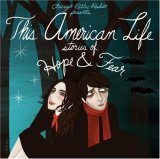 Ever have a friend who told really good stories about his or her life? Stories that were self-deprecating; tales of frustration, missed opportunities, or things that didn't turn out as expected; yarns that were at once funny, offbeat, happy, and sad? What if the stories were set to the perfect background music to enhance them and broadcast on the radio? Then you'd have This American Life, produced by Public Radio International and heard on thousands of public radio stations nationwide. If you took a bunch of those stories, grouped them loosely around the themes of hopes and fears, and put them out on CD, you'd have This American Life: Stories of Hope & Fear.
Ever have a friend who told really good stories about his or her life? Stories that were self-deprecating; tales of frustration, missed opportunities, or things that didn't turn out as expected; yarns that were at once funny, offbeat, happy, and sad? What if the stories were set to the perfect background music to enhance them and broadcast on the radio? Then you'd have This American Life, produced by Public Radio International and heard on thousands of public radio stations nationwide. If you took a bunch of those stories, grouped them loosely around the themes of hopes and fears, and put them out on CD, you'd have This American Life: Stories of Hope & Fear.If you've ever heard This American Life, you will know exactly what you're getting with this two-CD set. For the uninitiated, let me explain a little. This American Life was created by Ira Glass at Chicago Public Radio. The show is an hour long, and as Mr. Glass says at the beginning, "Each week on our show we choose a theme and offer you a series of stories on that theme." He then announces the subject of the show, how many acts it will play out in, who will tell each story, and a brief description of each act. The tales tend to be truthful rather than fictional and are always set to instrumental music that complements the story. Sometimes Ira Glass interviews someone or talks to someone as they tell a story; sometimes another interviewer assumes narrator duties; oftentimes, it is a lone voice essentially reading an essay set to music.
TAL has been around for more than a decade, but the format and tone have not grown old. The take on life presented here is like the ironic flip side of Norman Rockwell. These Americans run the gamut of behavior and emotions, but mostly the narratives have the feel of getting inside someone's head: what they were thinking, what they perceived, and how this falls short or is just totally different than the expected. The voice of the show is smart, funny, articulate, reflective, and idiosyncratic. The interviewers and story tellers do not sound unprofessional, but they don't sound like trained actors, either. It's all very conversational.
The tales on this CD set exemplify the TAL approach. The "hope" stories are not all that hopeful; rather, they are about what happens to hopes when we expose them to real life. Neither are the "fear" stories scary. They are about the fears we have and how we face them. Or more to the point, how we think about them.
The stories have both hilarious and touching moments. In them a new New York City resident has his hopes dashed about the quality of his apartment; coworkers try out the comedy sketches on the karaoke machine; a mother makes a videotape of herself so her mentally handicapped daughter will remember her when she's gone; a man who had a sex-change talks about his varied experiences of gender; a woman reads from her diary from when she was 13; a brother and sister remember how they made up a family to babysit for to get away from their mother's restrictions; a mentally handicapped man lists his fears; a woman has a ten-month tussle with MCI; a man ends up with his mother because his father can't accept that his son is gay; David Sedaris tells a tale of a chipmunk in love with a squirrel; and a man faces his fear of the monster ride on the boardwalk.
Stories of Hope and Fear might disorient someone who doesn't know the show, because it lacks the preliminary introduction about what it is one is listening to. Nor does Ira Glass give any kind of overview to the collection, he just launches in to the tales of hope, for which he gives a little spiel (no such tying together appears at all on the "fear" half of the CDs). It appears that no extra effort was put into creating this collection (one of TAL's "Greatest Hits" series).
Be that as it may, it is still a fantastic group of stories. There is nothing else around like This American Life, and this collection is a wonderful sample.
Cross-posted to Blogcritics.
No comments:
Post a Comment